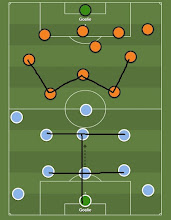A number of the first goalkeepers in their club had to wait for years to gain their spotlight after the main shot stopper’s retirement.
Being the second fiddle on the national team for a goalkeeper is rather
frustrating. One might have limited opportunities to hit the pitch in the major
competition, especially when the first choice seems unstoppable. Such is even
worse if the managers never consider rotating the men between the sticks. The
second goalies have often been touted as the second best for far too long and
would never have a chance to take the spot on the first team unless the first
shot stopper hung his gloves.
Such is what happens to Marc-Andre ter Stegen today. The Barcelona shot
stopper has been regarded as good as Manuel Neuer for the Germany national
team. Yet, Neuer always got the first nod in the line-up until the Bayern
skipper himself finally decided to retire. Ter Stegen is expected to be the
first choice in the upcoming major tournament, the 2026 FIFA World Cup, after
sitting on the bench for eight years so far.
What the former Gladbach’s man went through is not exactly new. There had
been others who were entangled in such a predicament. Interestingly, not all of
them did manage to put on a show as impressive as their predecessors, at least
the ones on the elite sides in the past two and three decades. Here are those
unfortunate yet patient understudies with the longest wait.
Gregory Coupet (France)
He was Lyon’s key man between the sticks when they clinched the Ligue 1
title seven times in a row. Coupet made his debut in 2001 during the FIFA
Confederation Cup in Japan and Korea. Unfortunately, he only remained the
second choice in major tournaments from 2002 and 2006 FIFA World Cup, and
EURO 2004. The experienced Fabian Barthez had been seemingly blocking his
chance due to the eccentric shot stopper’s constant top form with Les Blues.
His opportunity to get a nod in the lineup finally arrived at EURO 2008, as
Barthez was no longer actively playing. However, the former PSG and Atletico
Madrid man was unable to help his country progress. In fact, France had the
worst EURO campaign as they were winless and slumped in their last two matches
versus the Netherlands and Italy. Coupet eventually called for international
retirement in July 2010 after being excluded by Raymond Domenech for the World
Cup squad. He only received a call-up 34 times for international matches.
Chris Woods (England)
The former Sheffield Wednesday and Burnley shot stopper had to wait for
seven years to be named the first goalie on the England national team. He made
his debut in 1985 against the USA and eventually made the cut for the 1986 FIFA
World Cup squad. He went on to be Peter Shilton’s second fiddle in the 1988 and
1990 FIFA World Cups. His senior at last hung his gloves after Italy in 1990.
At the age of 34, he was finally given the spotlight by Sir Bobby Robson’s
successor, Graham Taylor, for EURO 1992, which was his first appearance as the
number one. Woods was actually fielded in the third game of the group stage
against the Soviet Union in EURO 1988, but his status was still an understudy,
and the Three Lions were already eliminated from the competition, so such a
match was merely a formality.
Santiago Canizares (Spain)
The former Valencia star from the late 1990s until the mid-2000s had been only
the second choice in La Furia Roja, despite his impressive debut against Denmark in 1994 FIFA World Cup qualifiers. Spain had the Basque-born legend, Andoni
Zubizarreta between the sticks at their disposal at that time.
He was part of the Spain squad in 1994, 1998, the 2006 FIFA World Cup, EURO 1996, and 2004 as either Zubizarreta’s or Iker Casillas’ understudy. Canizares,
who played in the opener against South Korea in 1994 to replace the suspended Barcelona man, finally made his major tournament appearances at EURO 2000.
Initially, he was still sidelined for Jose Molina at the opener, but Spain's
unexpected defeat to Norway became the real-eye opener that they should have
counted on the former Real Madrid youth team member as the great Zubizarretta's successor. He was then selected for
the remaining three games in the tournament.
Unfortunately, his place was then taken over by young Iker Casillas in the
next major competitions: the 2002, 2006, and 2004 World Cups. He had only been
in the team for one game against Saudi Arabia at the group stage.
Andreas Koepke (Germany)
He was Germany's hero during their triumphant campaign in EURO 1996. Koepke
contributed heavily to the competition as Bertie Vogts’ men clinched their
third continental title. However, the former Nuremberg and Marseille man had to
wait for eight years to finally get the nod as the first-choice goalie,
following Bodo Illgner’s early retirement from the international stage. The
World Cup hero in Italy in 1990 was still 27 at the time.
Koepke made his international debut against Czechia in 1992, four years
after his first call-up. He was part of the squad during Germany’s campaigns in
1990 and 1994 FIFA World Cup plus EURO 1992. Yet, he did not play a single game
in those competitions.
After his top form in England in 1996, Koepke remained between the sticks in
the 1998 FIFA World Cup, which unfortunately marked the decline of German
football as they relied on the ageing squad, including 38-year-old Lothar
Matthaeus, and suffered a humiliating 3-0 loss to Croatia in the quarterfinal.
It turned out to be his final appearance in a German shirt too.



Comments
Post a Comment